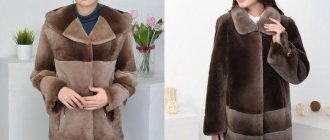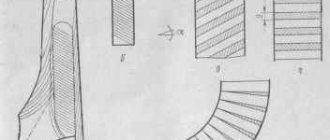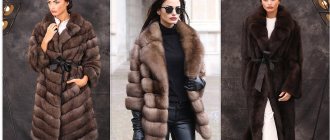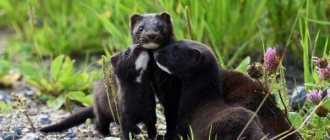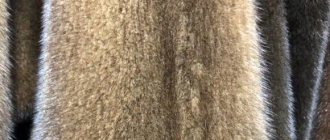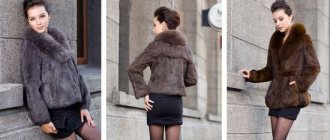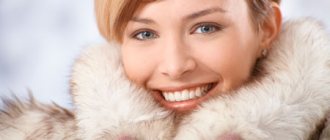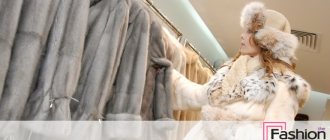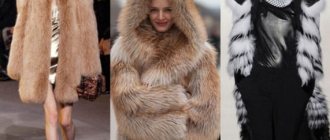Modern beaver fur industry
Nowadays, only the Canadian beaver is found on the fur products market, and rarely, on order, you can find products made from Kamchatka beaver fur. They are distinguished by color, from black to dark brown, reddish-brown Canadian. The latter, unlike its relatives, is not in danger of extinction. Kamchatsky is listed in the Red Book. There is a myth about coats made from swamp beaver fur. In this case we are talking about nutria, whose fur is less valuable and has no fluff. The idea of this product came from unscrupulous sellers hungry for easy money.
Beaver fur
Classification of beaver skins by color
There are five main colors of beaver fur: very dark, dark, brown, light and very light. In addition, the skins are divided according to their origin into two sections - western and eastern. The skins of the western section are lighter, while those of the eastern section are darker, even if they belong to the same color category.
Beaver skins come in a variety of colors.
Very dark
. The skin has a very dark, almost black back and lighter, gray sides and belly. The spine line is not clearly defined, the dark color partially covers the side parts of the skin.
Dark
. The skin is gray-brown in color, darker around the spine and lighter on the sides. In the area of the throat and tail there may be small spots of light straw color.
Brown
. The skin is brown-brown in color, slightly darker along the spine. The cervical and caudal sections often have light straw spots that are quite large. The beaver skins of the western section are lighter, while those of the eastern section are darker.
Light
. The skin is straw-colored with patches of brown and gray guard hairs. Along the ridge, inclusions of brown predominate, and on the sides - gray. The neck and tail sections are lighter than the general background of the fur.
Very light
. The skin is a very light gray color, with a darker, but less pronounced stripe running along the ridge. The fur is interspersed with light straw-colored guard hairs, arranged in such a way that the sides of the skin appear striped. The cervical and tail sections have straw-colored spots.
Advantages of fur, possible disadvantages
Speaking about the positive qualities of fur, one cannot fail to note the warmth that a beaver fur coat has. Regarding the appearance, the method of dressing the skins will not only make the dreams of any lady come true, but will also emphasize the brutality of the stronger sex. Beaver fur coats have been worn for many decades without losing their qualities. If we compare a plucked beaver and a sheared mink, then the beaver will gain advantages in terms of price/quality ratio due to its appearance and incredibly warm, dense pile.
The only inconvenience may be the price range when choosing products from different manufacturers. Do not forget that the weight of a fur coat, due to the density of the fur, exceeds the weight of other models.
Classification of beaver skins by fur quality
Beaver skins are classified according to the quality of the fur and the color of the guard hair. According to the quality of the fur, the skins are divided into six groups: selected fur, first grade, first-second grade, second grade, skins with slight damage, skins with minor damage.
Select group
. Represents the best quality skins from the lot. Very dense fur with underfur completely covered by guard hairs, the inner part is clean, light golden in color. The skin should not have any fur or flesh defects.
Selected beaver outerwear
First grade
. The fur is less dense than in the selected group, but the underfur is also completely covered with guard hair, the color of the underfur is allowed to be slightly bluish, with small spots. Defects of fur and flesh are also not allowed.
First-second grade
. The fur has a weak density, but the underfur is still completely covered by guard hair. The color of the flesh changes from light golden to blue, and dark spots form on it. Some broken spine is acceptable; flesh defects are not acceptable.
Second grade
. The skins are of low quality (flat), the density of the fur is very small, the guard hair does not cover the underfur, that is, the underfur is clearly visible. High spotting of the flesh and no more than three small defects of the fur or flesh are allowed.
Skins with slight damage
. This category includes beaver pelts with no more than three defects that may cause minor loss of covering hair. If there are no defects, these skins should be classified as selected or first grade.
Skins with minor damage
. These are selected skins or skins of the first grade, having from 4 to 6 minor defects or more than three large defects, leading to partial loss of covering hair and underfur. This group also includes skins of the first or second grade, having 4-6 minor defects leading to a slight loss of fur.
You can read more about the classification of skins by quality and the defects of fur raw materials here: The most common types of classification of skins of fur-bearing animals
Nuances of operation, subsequent care and storage
The product is quite rare, so the buyer is often lost when the question arises of how to distinguish beaver fur. To avoid becoming a victim of advertising, you must clearly understand:
- beaver must be expensive
- cut models look like a rabbit, but the pile is longer, after cutting it has a shimmer in the form of waves
- when ironing against the growth of the pile, there is a feeling of hardness and tingling
- plucked models are represented by single copies
- Beaver guard hair is stiffer than nutria, less often located along the skin
As for care, owners do not experience such a problem as cleaning beaver fur. The products are durable and not demanding on weather conditions. The main thing is to walk your beaver coat more often, like any other fur item. You can clean the fur by spraying starch, followed by combing. In case of severe contamination, it is necessary to contact a dry cleaner. The main thing is not to worry, beaver products are the most unpretentious and durable. Please wear it with pleasure!
Fur Portal
Today's beaver coat
has gained great popularity, because you can find it in the wardrobe of many women. Beaver is used by many designers, because this fur has unique properties.
Characteristics of beaver fur
One of the main features of the beaver is that it is perfect for the Russian climate. This fur is suitable for residents of both the northern and southern parts of the country. The beaver has a number of additional advantages that attract designers from all over the world.
- 1. Practicality and wear resistance. Beaver fur
does not require frequent dry cleaning or special storage conditions. In order for a fur coat to last 15-18 seasons, it is enough to monitor its appearance and prevent mechanical damage.
- 2. Good thermal insulation qualities. Thanks to its thick fur and undercoat, the beaver's skin
is highly dense. It retains heat even after a long stay in the cold.
- 3. Moisture resistance. As a rule, high humidity has a bad effect on the quality of fur products. However, beaver is resistant to any weather conditions, so it will not deteriorate even after wet snow or rain.
- 4. Aesthetic data. Beaver fur has a bright and rich color, the colors of which vary from light brown to dark brown. In addition, the fibers do not lose their softness and fluffiness after prolonged dyeing.
Beaver varieties
To make products, designers, as a rule, use beaver fur in its natural form. However, in order for the product to be attractive and practical, it is necessary to carry out some procedures for processing the fur. There are 3 types of beaver used to make fur coats:
- 1. Long beaver. Products made from this fur use natural long pile. Wool is characterized by shine and softness. The main qualities of this type of fur are practicality and water resistance. Most often, long beaver is used to make men's clothing.
- 2. Shorn beaver. Its main advantage is its low price. In addition, it is wear-resistant and practical. The color palette of sheared beaver is extensive - from light to dark shades of brown.
- 3. Plucked beaver. Since only whole skins are used in its production, this fur is more expensive than sheared fur. In its production, a special technology is used - fur plucking. This allows you to create a practical and high-quality product that does not lose its attractiveness even after prolonged wear.
Beaver coats
Beaver fur is quite difficult to use. For tailoring, only the skins of young animals, which are distinguished by the softness of their down, are used. Before sewing begins, a special fur processing technology is used.
- 1. Connecting fur skins for further procedures.
- 2. If it is necessary to obtain sheared or plucked fur, shearing or plucking is used.
- 3. Selection of colors, painting.
As a rule, fur processing occurs within a few months, but sometimes the process lasts more than a year. When choosing a fur coat, you need to pay attention to the features of not only the processing of the material, but also the tailoring of the product.
- 1. Size and length of the fur coat. Nowadays, short fur coats (length up to the knee) are considered fashionable, but if you want to get powerful protection from the cold, you can buy a long fur coat that reaches to your toes. When choosing the length of a fur coat, be guided not only by the latest fashion trends, but also by your preferences. It is important to check that the product is not too large or small for you. Check how well the fur coat fits you.
- 2. Style. When choosing a product cut, proceed from your body type and face shape. For example, a straight fur coat is perfect for thin girls, while flares look good on curvy women.
- 3. Type of fur. plucked beaver fur
is used to make women's fur coats . Decide which one suits you. Please note that the price and quality of these varieties differ, so it is better to choose the appropriate option before going to the store. If you cannot make a decision on your own, you can ask a sales consultant about the differences between these varieties.
- 4. Quality of cut. In order to check how correctly the fur coat was sewn, it is enough to conduct a small inspection. Inspect the product from all sides. If you do not see any damage or crooked seams, then the fur coat is made with high quality.
When buying a beaver fur coat, check its authenticity. Unscrupulous sellers often deceive buyers by offering nutria fur instead of beaver. At first glance, it is quite difficult to recognize a fake, but you can ask for a quality certificate. In addition, the seller is obliged to provide instructions for caring for the fur coat and a 1-year warranty. If store employees refuse to provide the necessary documents, then it is a fake.
Beaver products are distinguished by their quality and wear resistance. They are suitable for women of any age and body type, so every “fashionista” can purchase a product made from this fur!
You'll like it!
11 PHOTOS of the most expensive fur products...
Share!
Beaver fur care
First of all, it is worth remembering that when purchasing fur, high-quality care instructions must be included (this may not apply to products made from artificial Rex rabbit fur).
Important. It is proper operation that can extend the life of beaver fur.
Handbag
- You should never carry a bag over your hand, as this will create creases on the sleeve that cannot be dealt with. In addition, bald spots may appear.
- It's better not to walk in the rain for a long time. Rabbit fur will hold up, but the product itself may become deformed.
- To prevent the fur coat from stretching, you should not hang it on a hook, but be sure to purchase hangers.
- If the fur coat gets wet, then before drying it is recommended to dry it well so that a minimum of moisture remains.
Beaver model
- During the warm season, it is better to purchase special bags for storing fur products (they are impregnated with special oils against pests) or take care of anti-moth products.
Thanks to these simple rules, a beaver fur coat will last as long as possible.
How to distinguish beaver fur from rabbit fur?
Knowing what beaver fur looks like, it will certainly be easier not to make a mistake in choosing a product. Of course, it will ultimately be impossible to find out what kind of fur you bought without an examination or consultation with a specialist. To purchase products you need to have at least a simple idea about them.
You can only check whether the fur belongs to a beaver by touch. First you need to run your hand along it along the fur; the hair will be very soft. If you run your hand against the growth of the hair, the hair will turn out to be quite prickly and tough. For comparison: if you iron a rabbit skin against the direction of hair growth, it will still be soft and silky. The beaver's leather tissue is an order of magnitude tougher, while the rabbit's is very soft.
The next criterion is the presence of undercoat, which has already been mentioned more than once above. Next, you need to rub the bottom layer of the skin; if it crunches, you have a rabbit, if not, it’s a beaver. And the last factor is the geometry of the stitched skins. To do this, you need to be very careful and try to look at the areas. If the fur coat is made from beaver, then the length of the side of the rectangular section will reach 40-50 cm, while for products made from rabbit it will be a maximum of 25-35 cm.
Pros and cons of fur
As is already clear from the article, beaver fur is worthy of being in the wardrobe of any woman. The following advantages can be noted:
- beautiful and rich shine;
- high density;
- wear resistance;
- softness of the product;
- During production, fur does not need to be cut;
- availability.
Variety of vests
It’s difficult to talk about the disadvantages of beaver vests, but a couple can still be highlighted:
- cannot withstand low temperatures, i.e. for city winters up to -25 is suitable, but if the temperature is lower, you should take a closer look at something else;
- low service life compared to other fur coats (about 7 years);
- With errors or inattentive care, light-colored products begin to turn yellow.
You may be interested in: Tips for choosing fabric for summer dresses
A cap
Reviews
Nika: I had been planning to buy a fur coat for a very long time and finally decided, because this wardrobe item was necessary for a comfortable winter. In search of my ideal, I visited a large number of famous stores. I went with the intention of wearing mink, but after seeing enough of these same type of fur coats, I decided that I wanted something different, not like everyone else. And then they gave me a beaver fur coat. It was instant love - soft, light, beautiful, a chic coffee-with-milk color. I don’t drive a car, so it was important for me that the fur coat covered both my butt and my head. So I settled on a thigh-length model with a hood. The downside for me was the collar, which did not cover my neck tightly, but the scarf corrects everything. Overall, I'm very pleased with it.
Miroslava: I am one of those who dreamed of a fur coat for a long time, but could not afford it. I didn’t even look at the mink, more towards the beaver. But when I came across a beaver on the Internet I immediately became interested. I doubted it, after all, it was rabbit fur. But as it turned out, this was exactly what I needed. Soft, cozy. Met all expectations. The only BUT! If it’s bitterly cold outside, about -20, I’m freezing. Now I know what kind of fur beaver is.
Beaver fur is an excellent option for models with low cost and excellent quality.
Color options
If the owner of a fur coat is afraid of bright colors, then the natural beaver color is a win-win option; it is beautiful and delicate. However, for those who like something bold, rich colors have come into fashion. The trend now is blue, red, different shades of green, purple. For those who like to stand out, there are even printed products. It usually looks like a geometric pattern that shows through the fur.
Bold decisions are suitable mainly for young girls, but women prefer colors that will refresh their appearance and emphasize their status, these are white and beige. Classic colors (for example, black, brown, orange) look great on very old ladies.
You might be interested in what the fabrics used to create a coat are made of: types of materials
Not so long ago, such a bold decision as combining colors came into fashion. For example, a fur coat goes well with white/black, white/beige or grey, black/red or blue.
Bright shades
Table of wear resistance of different types of fur
| Fur name | Wear resistance of fur in points |
| Otter unplucked | 100 |
| Wolverine | 100 |
| Otter plucked | 95 |
| Brown and black bear | 95 |
| Kamchatka beaver (sea otter) | 95 |
| Plucked river beaver | 85 |
| Natural seal | 80 |
| Natural sable | 80 |
| Painted seal | 75 |
| Natural raccoon | 75 |
| Leopard | 75 |
| Painted sea cat | 70 |
| Natural skunk | 70 |
| Natural mink | 70 |
| Soft natural marten | 65 |
| Sable tinted | 65 |
| Painted raccoon | 60 |
| Astrakhan | 60 |
| Arctic fox blue | 60 |
| Natural wolf | 60 |
| Smushka | 60 |
| Painted skunk | 55 |
| Dyed mink | 55 |
| Sheepskin | 55 |
| Painted soft marten | 50 |
| Natural mountain marten | 45 |
| Muskrat | 45 |
| Opoek | 45 |
| Korsak | 45 |
| White Arctic fox | 45 |
| Painted mountain marten | 45 |
| Natural fox | 40 |
| Painted wolf | 40 |
| Nutria unplucked | 40 |
| Opossum | 40 |
| Painted fox | 35 |
| Painted muskrat | 35 |
| Foal | 35 |
| Polecat | 35 |
| Natural lynx | 30 |
| Jackal | 27 |
| Natural squirrel | 27 |
| Fox painted black | 25 |
| Ermine | 25 |
| Columns | 25 |
| Nutria plucked | 25 |
| Possum painted | 20 |
| Wiesel | 20 |
| Lynx painted | 20 |
| Painted squirrel | 20 |
| sand squirrel | 20 |
| Marmot | 20 |
| Goat | 15 |
| Broadtail | 15 |
| Chinchilla | 15 |
| Rabbit | 12 |
| Common gopher | 10 |
| Brown hare | 5 |
There is a comparative wear resistance of fur types in points, where the wear resistance of otter fur is taken as 100 points, corresponding to approximately 20 winter seasons of use, subject to proper storage.
What models of beaver fur coats are popular?
The coming winter season offers fashionistas many interesting and modern products made from beaver fur:
- fitted fur coats that can be worn with or without a belt, knee-length;
- short fur coats mid-thigh length;
- straight products with a hood;
- short jackets with a zipper or buttons;
- straight short fur coats with a stand-up collar and ¾ sleeves;
- products with brightly colored fur;
- long fur coats with a hood trimmed with silver fox fur;
- flared short fur coats;
- vests with leather belt.
What colors are offered to fashionistas?
Natural color is always in fashion, but this season other colors of beaver coats are also popular. Girls choose fur products dyed in rich blue, emerald, bright red, purple, and canary colors. No less popular are fur coats with geometric prints, that is, products in which horizontal stripes are visible in color. They are created in a special way and give the fur coat originality. White and light beige shades are popular among middle-aged fashionistas. They are refreshing and look very elegant and expensive. Older ladies choose classic colors: black, dark brown, walnut, burgundy, plum.
Over time, the light shade may turn yellow.
Extravagant fashionistas choose two-tone fur coats. The most popular color combinations:
- black + white;
- white + gray;
- white + beige;
- black + red;
- blue + black;
- plum + black.
Beautiful accessories highlight the originality of the product. A short sheepskin coat or long vest can be worn with a wide leather belt. A sophisticated and noble look in a long fur coat without a hood will be emphasized by a beautiful shawl or a wide scarf with fringe.
Accessories should emphasize the beauty of the product, and not cover it up.
Features of beaver fur
As mentioned above, the difference in the thickness and length of Rex’s fur compared to an ordinary rabbit is as much as 2 times. The skin itself of the former is also an order of magnitude thicker, therefore, in order to sew a fur coat, you need to do a number of procedures, namely:
- soak the skin in a special solution;
- dry it thoroughly;
- stretch.
Thanks to these manipulations, it becomes much thinner.
Beaver product
Important. The fur of this animal does not wrinkle under mechanical stress, and if it breaks, it quickly returns to its place. This makes caring for the product much easier. When wet, the beaver dries quickly and does not lose its appearance.

